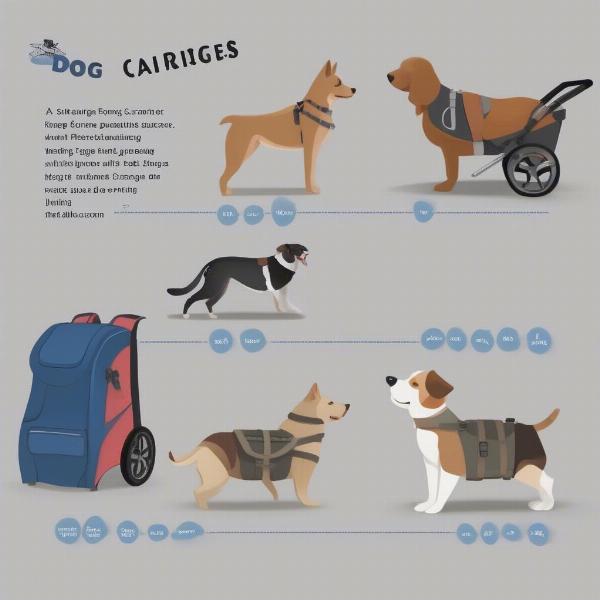Dog carriers are becoming increasingly popular for walking, providing a safe and comfortable way to transport your dog, especially in crowded areas, on public transport, or for dogs with mobility issues. Choosing the right carrier depends on several factors, including your dog’s size, breed, and temperament, as well as your personal walking habits and the environment. This comprehensive guide will help you navigate the world of dog carriers for walking and find the perfect fit for your furry companion.
Types of Dog Carriers for Walking
 Different types of dog carriers for walking: backpack, sling, stroller, and front carrier
Different types of dog carriers for walking: backpack, sling, stroller, and front carrier
Several types of dog carriers are designed for walking, each with its own pros and cons:
- Backpack Carriers: Ideal for hiking and longer walks, distributing weight evenly across your back. These are generally suitable for small to medium-sized dogs.
- Sling Carriers: Offer a cozy and secure way to carry smaller dogs close to your body, freeing up your hands. These are best for toy breeds and puppies.
- Strollers: Provide a comfortable ride for dogs who cannot walk long distances or have mobility issues. They are available in various sizes to accommodate different breeds.
- Front Carriers: Allow you to keep a close eye on your dog while walking, offering a secure and comfortable experience for both of you. Suitable for smaller breeds.
Choosing the right carrier depends on your individual needs and your dog’s preferences.
Choosing the Right Size and Fit
Ensuring a proper fit is crucial for your dog’s comfort and safety. Measure your dog’s length, height, and width to determine the appropriate carrier size. The carrier should be large enough for your dog to stand, sit, and turn around comfortably. A carrier that is too small can restrict movement and cause discomfort, while one that is too large can be unstable and unsafe. Always consult the manufacturer’s size guidelines and consider your dog’s weight when choosing a carrier.
Features to Consider
Several key features can enhance the comfort and functionality of a dog carrier for walking:
- Ventilation: Adequate ventilation is essential for your dog’s comfort, especially in warmer weather. Look for carriers with mesh panels or windows.
- Padding and Support: Padding on the straps and interior of the carrier can enhance your dog’s comfort and prevent chafing.
- Safety Features: Look for secure closures, adjustable straps, and leash attachments to ensure your dog’s safety.
- Durability and Water Resistance: Choose a carrier made from durable and water-resistant materials to withstand regular use and various weather conditions.
- Ease of Cleaning: A carrier that is easy to clean is essential for hygiene. Look for removable and washable liners.
Getting Your Dog Used to the Carrier
Introducing your dog to the carrier gradually is key to a positive experience. Start by placing the carrier in a familiar area and allowing your dog to explore it at their own pace. Reward them with treats and praise for positive interactions. Gradually increase the time your dog spends in the carrier, eventually closing the carrier and taking short walks around the house. This gradual introduction will help your dog associate the carrier with positive experiences, making walks more enjoyable for both of you.
Conclusion
Choosing the right dog carrier for walking can significantly improve your and your dog’s experience. By considering factors such as your dog’s size, breed, and temperament, as well as your personal walking habits and the environment, you can select a carrier that provides comfort, safety, and convenience. Remember to introduce your dog to the carrier gradually and prioritize features such as ventilation, padding, and safety features. With the perfect carrier, you and your furry friend can enjoy many happy walks together.
FAQ
- How do I choose the right size dog carrier for my dog? Measure your dog’s length, height, and width and compare these measurements to the manufacturer’s size guidelines.
- Are backpack carriers suitable for all dog breeds? Backpack carriers are typically best for small to medium-sized dogs. Larger breeds may be too heavy or large for backpack carriers.
- How can I get my dog used to a carrier? Introduce the carrier gradually, rewarding positive interactions with treats and praise.
- What are the most important safety features to look for in a dog carrier? Secure closures, adjustable straps, and leash attachments are crucial safety features.
- How do I clean a dog carrier? Look for carriers with removable and washable liners for easy cleaning.
- Can I take my dog on public transportation in a carrier? Check the specific regulations of your local public transportation system regarding pet carriers.
- What are the benefits of using a dog carrier for walking? Dog carriers provide safety, especially in crowded areas or for dogs with mobility issues, and they can be convenient for public transport.
ILM Dog is your trusted source for comprehensive information on dog care and wellbeing. We cover a wide range of topics, from breed selection and health care to training, nutrition, grooming, and product recommendations. If you’re looking for expert advice and practical tips on how to best care for your canine companion, look no further. Whether you’re a seasoned dog owner or just starting your journey, ILM Dog provides the resources you need to ensure your dog thrives. Contact us today for personalized guidance and support. Email: [email protected] Phone: +44 20-3965-8624.